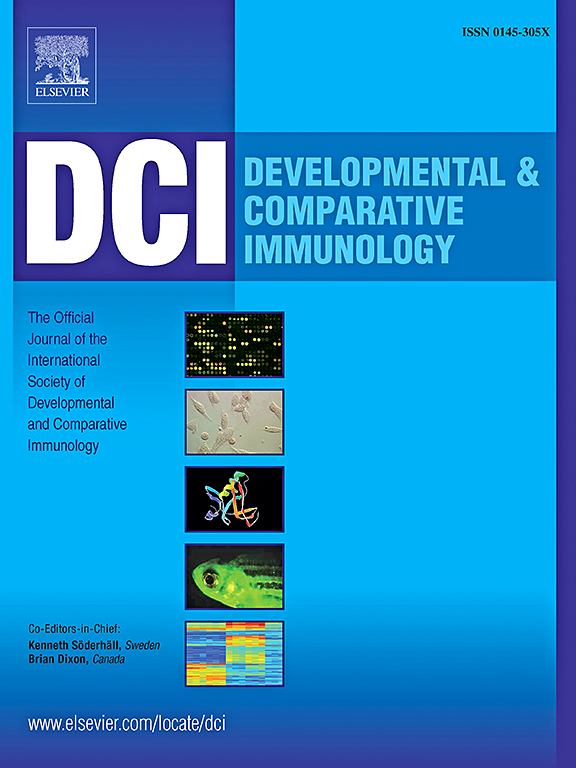受血液病感染的十足甲壳类动物的血液学恶化。
IF 2.7
3区 农林科学
Q1 FISHERIES
引用次数: 0
摘要
寄生鞭毛虫,即血鞭毛虫,在世界范围内感染了越来越多的十足甲壳类动物。这些寄生虫是欧洲和北美渔业长期关注的问题,也是亚洲水产/混养系统的新问题。被称为苦/粉红/乳蟹病或脱毛后综合征的血液病感染可能是致命的,但没有治疗或疾病管理策略。我们询问了现有的文献,以提高对血甲壳类动物病理系统的认识,特别是寄生虫病期间的血淋巴状况。在这种情况下,我们试图确定在血淋巴中是否存在不变的生物标志物(生物化学,细胞)。使用荟萃分析方法,我们仔细审查了已发表的数据,并从17项原始研究中收集了191个效应量,这些研究符合严格的纳入标准,涵盖了既定的血液学特性,如酚氧化酶活性,并运行了一系列广义线性混合模型。为了考虑环境变量(水温、盐度)、寄主性状(性别、大小)和寄生虫负担之间的假定联系,还构建了其他模型。总的来说,在螃蟹和海螯虾中,血细胞数量(如透明细胞)和蛋白质水平(如血青素)的减少与血青素的存在一致。当外部盐度水平超过30 psu时,甲壳类动物更有可能出现严重的血液病负担,并且可能在20oC时免疫受损。与在实验室试验中感染的动物相比,在野生捕获的动物中,血液驱动的低蛋白血症和血细胞减少症更为明显,因此强调需要在自然环境中获得数据。这是首个荟萃分析研究,提供了明确的证据,支持被血足菌寄生的甲壳类动物广泛的血液学恶化,以及与免疫病理相关的环境因素。本文章由计算机程序翻译,如有差异,请以英文原文为准。
Haematological deterioration of Hematodinium-infected decapod crustaceans
Parasitic dinoflagellates, namely Hematodinium spp., infect a growing number of decapod crustacean species worldwide. These parasites represent a longstanding concern for fisheries in Europe and North America, and an emerging concern for aqua/polyculture systems in Asia. Known as bitter/pink/milky crab disease or post-moult syndrome, Hematodinium spp. infection can be fatal, yet there are no treatments or disease management strategies. We interrogated the available literature to enhance knowledge of Hematodinium-crustacean pathosystems, specifically haemolymph condition during parasitaemia. In this context, we sought to determine if there were invariant biomarkers (biochemical, cellular) in the haemolymph. Using meta-analytic approaches, we scrutinised published data and gathered 191 effect sizes from 17 original studies (out of >1790) that met strict inclusion criteria covering established haematological properties like phenoloxidase activity, and ran a series of generalised linear mixed models. Additional models were constructed to consider the putative links between environmental variables (water temperature, salinity), host traits (sex, size), and parasite burden. Overall, depleted haemocyte numbers (e.g., hyaline cells) and protein levels (e.g., haemocyanin) coincided with patent Hematodinium presence in crabs and langoustine. Crustaceans were more likely to have severe burdens of Hematodinium when external salinity levels exceeded 30 psu, and potentially immune-compromised ≥20°C. Hematodinium-driven hypoproteinemia and hematocytopenia were more pronounced in wild-caught animals than those infected in laboratory trials, thereby emphasizing the need to secure data in natural settings. This is the first meta-analytic study to present clear evidence in support of broad haematological deterioration in crustaceans parasitised by Hematodinium spp., and environmental factors linked to immunopathology.
求助全文
通过发布文献求助,成功后即可免费获取论文全文。
去求助
来源期刊
CiteScore
6.20
自引率
6.90%
发文量
206
审稿时长
49 days
期刊介绍:
Developmental and Comparative Immunology (DCI) is an international journal that publishes articles describing original research in all areas of immunology, including comparative aspects of immunity and the evolution and development of the immune system. Manuscripts describing studies of immune systems in both vertebrates and invertebrates are welcome. All levels of immunological investigations are appropriate: organismal, cellular, biochemical and molecular genetics, extending to such fields as aging of the immune system, interaction between the immune and neuroendocrine system and intestinal immunity.

 求助内容:
求助内容: 应助结果提醒方式:
应助结果提醒方式:


